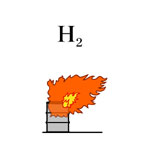| Case Name |
Fire of gas leaked from a flange of piping at a vacuum gas oil hydro-desulfurization unit |
| Pictograph |

|
| Date |
September 27, 1989 |
| Place |
Takaishi, Osaka, Japan |
| Location |
Refinery |
| Overview |
At a vacuum distillate hydro-desulfurization unit in operation, hydrogen and vacuum gas oil blew out from an outlet piping flange of a new reactor. A fire occurred. As tightening management of hot bolting at start-up three months before was inadequate, the flange opened and the gas leaked. |
| Incident |
In a refinery, a fire occurred during usual operation at a new reactor of a vacuum distillate hydro-desulfurization unit. Internal gas (hydrogen, hydrocarbon, etc.) blew from a flange of upper piping in the reactor. It ignited and flames 0.5-2 meters high spurted. Insufficient hot-bolting three months before at the beginning of operation was the cause. Refer to Fig2. |
| Processing |
Manufacture |
| Individual Process |
Reaction |
| Chemical Reaction |
Other (hydro-desulfurization) |
| Substance |
Hydrogen, Fig3 |
| Vacuum gas oil |
| Type of Accident |
Leakage, fire |
| Sequence |
The 2nd reactor of a vacuum distillate hydro-desulfurization unit was completed in June, 1989. Operation started and hot-bolting was executed at about 200 and 360°C while the temperature was rising. Continuous operation started.
About 19:55 on September 27. In a reactor with a height of 13 m, vacuum distillate containing hydrogen blew from a flange of upper piping. It ignited and a flame 0.5-2 m high was formed.
20:00. An emergency call to the fire department was made. An emergency shutdown started. Pressure was reduced from operating pressure of 10 MPaG.
20:08. Public fire brigades arrived. For fear of a secondary disaster with hydrogen sulfide, they stood by without extinguishing the fire with water.
20:44. The fire extinguishment was confirmed.
20:45. The pressure in the reactor lowered to 0.6 MPaG. Nitrogen gas was introduced into the system.
21:20. Pressure lowered to 0.3 MPaG or less. Cooling by feeding nitrogen gas was continued. |
| Cause |
The cause was considered to be a loose flange due to uneven tightening force with uneven thermal expansion of materials at 10-inch piping where gas flowed at 390 °C and 10MPaG. Concretely, the following is pointed out.
1. There was not a sufficient margin for tightening force on hot-bolting.
2. The material of the upper part of the flange was SUS321 and at the lower part was 2-1/4Cr-1Mo with an overlay. Coefficients of thermal expansion differed.
3. Furthermore, thermal expansion of piping acted in the direction of opening the flange. |
| Response |
An emergency shutdown of the unit. The fire department was called. Cooling by feeding nitrogen gas. |
| Countermeasures |
Hot-bolting, after exceeding 360 °C, should be done at every 30 °C. Reviewing hot-bolting, and strengthening the management system. A special check team was set up for the flange of a high-temperature and high-pressure part of newly constructed piping and vessels. The team carried out periodic inspections.
Regulations of hot-bolting were reviewed and the management system for bolt-tightening force was strengthened. |
| Knowledge Comment |
Quantitative management is required for managing tightening forces of flanges of high-temperature and high-pressure parts. Furthermore, the number of times and timing are important.
All flanges for which hot-bolting is performed are not used under the same conditions. Probably, the conditions for hot-bolting should be set up on the basis of the severest conditions. |
| Background |
2. and 3. pointed out as concrete causes in the "Cause" column are not problems of the whole system but unique problems only of this flange. It is speculated that problems due to unique conditions were overlooked and examination was insufficient.
Many units based on this process probably were operated at that time.
There must have been enough information about the method and the number of times of hot bolting. It is thought that the problem was in operation management and maintenance management. |
| Incidental Discussion |
As operating conditions at high temperatures and high pressures are severe, check and maintenance must be carried out thoroughly. Moreover, during assembly work after an overhaul, it is better regarding the parts as new ones whose functions have not been proven than intending to re-assemble the old parts. |
| Reason for Adding to DB |
Example of fire caused due to insufficient hot-bolting |
| Scenario |
| Primary Scenario
|
Organizational Problems, Poor Management, Slackness of Management, Carelessness, Insufficient Precaution, Mannerism, Usage, Maintenance/Repair, Hot Bolting, Failure, Fracture/Damage, GasketFailure, Secondary Damage, External Damage, Leakage/Fire, Loss to Organization, Economic Loss, Direct Monetary Damage 34 million yen
|
|
| Sources |
Fire and Disaster Management Agency, Major cases of accident, Oil leakage fire from piping at reactor outlet in vacuum distillate desulphurization unit. Accident cases of dangerous materials. pp.35, 64-65.
High Pressure Gas Safety Inst. of Japan, High-pressure gas protection overview, pp.154, 170 (1990).
High Pressure Gas Safety Inst. of Japan Vacuum distillate desulphurization unit, leakage and fire at outlet piping flange, Accident examples of Petroleum refinery and Petrochemical units, pp.34-37 (1995).
|
| Physical Damage |
Heat damage to an octagonal ring
Some of vacuum distillate oil was lost. |
| Financial Cost |
¥ 34 million. (Accident examples of dangerous materials). |
| Multimedia Files |
Fig2.Figure of the accident
|
|
Fig3.Chemical formula
|
| Field |
Chemicals and Plants
|
| Author |
ITAGAKI, Haruhiko (Japan National Institute of Occupational Safety and Health)
TAMURA, Masamitsu (Center for Risk Management and Safety Sciences, Yokohama National University)
|